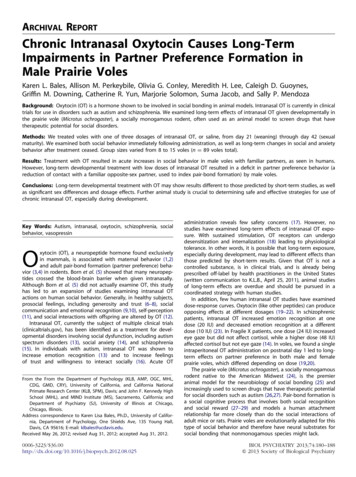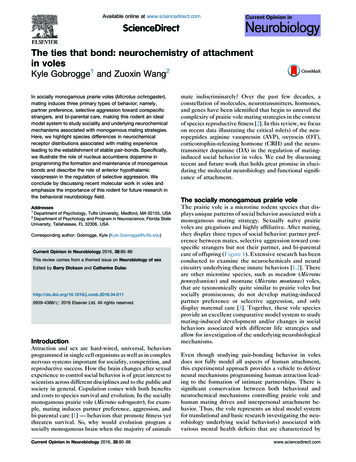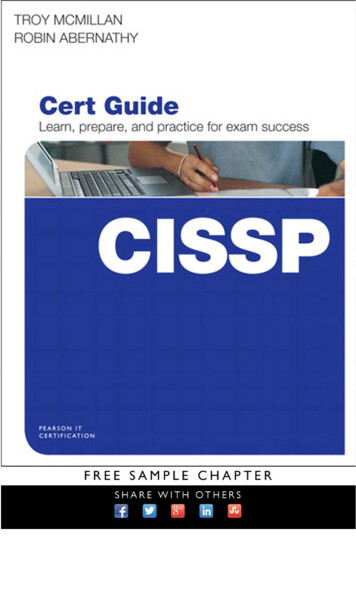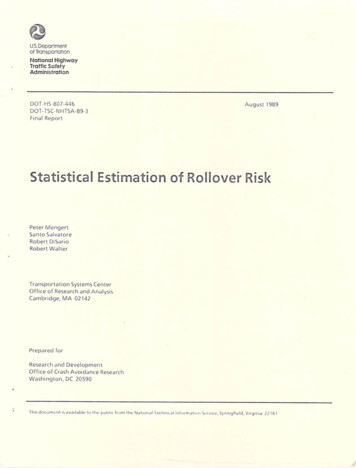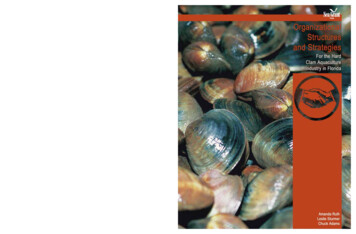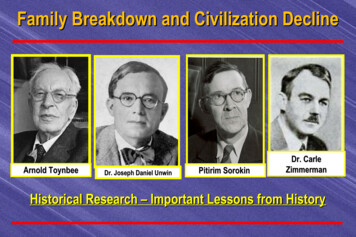
Transcription
Gustavus/Howard Hughes Medical Institute Outreach Program2011 – 12 Curriculum MaterialsMonogamy versus Promiscuity in VolesDocument Overview:Description of LessonVideo ClipsRecommended Prior Knowledge for StudentsExtensionsClassroom Handout for ResearchStudent HandoutMinnesota State Science Standards:9.4.1.1.1 Explain how cell processes are influenced by internal and external factors, suchas pH and temperature, and how cells and organisms respond to changes in theirenvironment to maintain homeostasis.9.4.3.3.4 Explain why genetic variation within a population is essential for evolution to occur.9.4.3.3.6 Explain how genetic variation between two populations of a given species isdue, in part, to different selective pressures acting independently on each population andhow, over time, these differences can lead to the development of new species.Objectives: Students will compare and contrast prairie voles with montane voles in terms of physicaldescription, diet, habitat, mating behaviors, and rearing of young. Students will discuss possible causes for the differences in reproductive behaviors between prairievoles and montane voles. Students will discuss pros and cons of monogamy versus promiscuity in the two vole species. Students will analyze data involving the impact of hormones on brain function and behavior. Students will analyze the evolutionary connection between habitat and behavior differenceamongst the two vole species.Type of Activity: Research and DiscussionDuration: 1-2; 50-55 minutesConnection to Nobel speakers:Speaker: Larry J. Young, Ph.D. William P. Timmie Professor, Department of Psychiatryand Behavioral Sciences, Emory University School of Medicine, and collaboratoryleader, Center for Behavioral Neuroscience, Atlanta, Ga. Larry Young has spent his professional life trying to understand the relationshipbetween genes, brain, and innate behaviors. As a postdoctoral fellow he beganinvestigating the molecular mechanisms underlying social attachment in prairievoles, which differ from other species of voles in forming lifelong social bonds.
Gustavus/Howard Hughes Medical Institute Outreach Program2011 – 12 Curriculum MaterialsEarlier research had identified two hormones in the regulation of pair bondformation in prairie voles and, using comparative molecular approaches, Younginvestigated the molecular mechanisms underlying the species’ differences inbehavior. His lab is now using interdisciplinary approaches to understand howspecific genes regulate the expression of innate behaviors, with a continuingfocus on social attachment and social behavior in general. By understanding themechanisms underlying social attachment, he and his colleagues hope to gaininsight into human disorders characterized by social impairments, includingautism spectrum disorders and schizophrenia.Materials:Computer/Internet Access and/or provided articlesVideo Clips (internet)Student HandoutColored PencilsDescription of Lesson:In this lesson, students will explore the vastly different reproductive strategies of two closelyrelated species of voles: Prairie voles and Montane voles. The teacher may choose to providean anticipatory set by discussing monogamy with students: What the term means, why it may ormay not occur amongst human couples (divorce rate), pros and cons of monogamy in humans,etc. Students will begin by researching the two different species of voles using the providedhandout. The teacher may choose to provide students with the provided in-class article to supportthe research or allow them to search on their own. Upon completion of the research, studentswill watch the video clip: “Why Do Voles Fall in Love?” as well as a series of video clips fromNobel Conference 2011 speaker, Larry Young, PhD. The teacher may choose to have studentsanalyze and interpret the actual data provided in the article individually or in groups as some ofthe content is rather deep. “Vasopressin in the vole brain”, an fMRI picture, may be viewed asa class. (http://www.psy.fsu.edu/ wanglab/photos.htm) At a basic level, the teacher may askstudents to identify where the pleasure center is in the vole brain, and how they know. Anotheroption is to challenge students to determine, in their own words, what the data in the providedarticle conveys. Finally, the teacher may choose to have students complete the analysis questionsindividually, with a partner, in groups, or as a large-class discussion.Note: The teacher may use this lesson with ecology, evolution, genetics, or body systems.Video Clips: Why Do Voles Fall in Love? http://research.yerkes.emory.edu/Young/index.html
Gustavus/Howard Hughes Medical Institute Outreach Program2011 – 12 Curriculum Materials Series of 8 video clips surrounding Larry Young and his research: http://www.dnalc.org/search?q volesRecommended Prior Knowledge for Students:It would be helpful, but not required, for students to understand how neurons andhormones function.Extensions:1. Supplementary Article about human hormones and pair-bonding: “Genetic variation inthe vasopressin receptor 1a gene (AVPR1A) associates with pair-bonding behavior 3.full.pdf html2. General info:“The annual vole meeting”. ml3. Conservation: The prairie vole population is threatened by the increase of agriculture inthe midwest. Voles can be viewed as pests or as essential to a habitat. They are apart ofthe natural food webs in their niche. Have students research whether voles are threatenedor regarded as pests.Importance of the eVole.pdfVoles in the n/horticulture/M1280.htmlNorthern Rockies Natural History Guide/ montane vole: http://nhguide.dbs.umt.edu/index.php?c mammals&m desc&id 194. MN DNR-Voles: http://google.dnr.state.mn.us/search?q voles&site PublicSite5. Albert Einstein’s: Thinking about Thinking. Here’s your chance to be an ethologist(“animal behaviorist”). This is an inquiry activity that can be done as homework or anin-class assignment. Students observe a group of animals for an hour. They then analyzethe behavior of the group and of the individuals and the relationships that occur. Arethere benefits to group and individual behaviors? http://www.pbs.org/safarchive/4 class/44 guides/guide 903/4493 thinking.html6. Students may research other animals (especially mammals) that are monogomous.7. How the termite brain works. General information on the termite and how its brainfunctions. 2/hive minds.html
Gustavus/Howard Hughes Medical Institute Outreach Program2011 – 12 Curriculum Materials8. Termite Lab Activity. Termites work in a cooperative community to meet the needsof all individuals in a colony. This lab can be used to test how an animal’s behaviorchanges based on the pheromones in an ink pen. How does cooperative behavior assist inthe survival of the colony? How do pheromones assist the colony? How do pheromonesinteract with neurons and the pln/termtrails.pdf9. Pill Bug Lab. This is an AP biology lab that can be modified to look at individualbehavior as well as behavior of the bugs as a group. Students can use this lab tocomment on how the behavior of the pill bug could be linked to behaviors of the voles.Do the bugs work as individuals or as a group? Can you measure pleasure? How is itmeasured in the pill bug? By eating the food? By moving away from isopod behavior lab.html10. Darwin’s “The Descent of a Man” Chapter VIII. There is a section on the principlesof sexual selection and polygamy in animals that can be used as a higher level reading.Students can identify animals and their sexual selection preferences.http://www.darwin-literature.com/The Descent Of Man/10.htmlMore Resources: Vole Photo Gallery: http://www.psy.fsu.edu/ wanglab/photos.htm Voles Facts for Kids: http://www.pestworldforkids.org/voles.html Article: Love is a chemical addiction http://www.oxytocin.org/oxytoc/love-science.html mistry d/templates/student resources/0030244269 campbell/HotTopics/Love.html Love is a Virus: http://www.corante.com/loom/archives/2004 06.html
Gustavus/Howard Hughes Medical Institute Outreach Program2011 – 12 Curriculum MaterialsClassroom Handout for Research:MonogamousVolesIntroduction:If you watch prime-time television, or read celebrity gossip magazines, you might come to theconclusion that monogamy is an unnatural condition. And in many animals, in fact, it is: themale sticks around just long enough to mate with a female, and then leaves her to take care of thekids. But other animals are genetically programmed to settle down with a long-term partner. Inthis Science Update, you’ll hear about two different species of rodents, called voles, which havetwo very different strategies in this department. What sets them apart?Transcript with Dr. Young:A rodent's cheating heart.Why is one male monogamous, while another plays the field? In humans, that's stilldifficult to answer. But in little mouse-like rodents called voles, scientists are getting apretty good idea.Larry Young is a researcher at Emory University and the center for behavioralneuroscience. He says one vole species, called the Montane vole, is promiscuous -- the maleskips out on his mate as soon as she's pregnant. But his closely related cousin, the prairievole, is monogamous.Young: They form these long lasting social attachments with each other. And the males andfemales nest together, they have their babies, and the males spend just as much time taking careof those babies as the females do.So why are they different? Young says a prairie vole gets a natural high from being with itsmate, while the Montane vole doesn't.Young: When a monogamous prairie vole mates, vasopressin is released and it activatesreceptors in certain areas of the brain that are involved in pleasure and reward. And they're
Gustavus/Howard Hughes Medical Institute Outreach Program2011 – 12 Curriculum Materialsactually the same areas of the brain that amphetamines and cocaine act on to produce addiction.Young says understanding how such behaviors are controlled in simpler creatures couldsomeday help us understand our own.For the American Association for the Advancement of Science, I'm Bob Hirshon.Figure 3 Vasopressin V1a receptor and attachment in prairie vole male. a Montane andprairie voles have different distributions of V1a receptor binding, with prairie voles havingrelatively high densities of receptors in the ventral pallidum (VP). (LS, lateral septum.) b Thespecies differences in receptor distribution are probably responsible for the species differencesin the behavioural effects of arginine vasopressin (AVP) and perhaps in the formation ofsocial attachments. In a test of nonspecific affiliative behaviour, intracerebroventricularAVP infusions increase social interest in the male prairie vole but not in the montane vole.Furthermore, AVP stimulates the formation of a partner preference in the absence of matingand V1a receptor antagonists prevent partner preference formation after extensive mating bouts.(CSF, cerebrospinal fluid.) c These species differences in receptor distribution might be theresult of species differences in gene structure. The prairie vole V1a receptor gene has beenduplicated with one copy being downstream of a retrotransposon element (LINE) and it alsohas a frameshift mutation in the coding region. Both copies have a large complex repetitiveexpansion (red) just over 700 bp from the transcription start site. Either the gene duplicationor the promoter expansion could contribute to the evolution of the expression pattern. (Figuremodified with permission from Ref. 70 (1999) Macmillan Magazines Ltd.)Vasopressin in the Vole BrainPrairie VoleMontane VoleMaking Sense of the Research:Scientists have long been interested in the biological roots of mating behavior, since animalshave so many different strategies and social norms. In this case, remember that we're not talkingabout apples and oranges: these are two different kinds of voles, with pretty subtle differencesbetween them.The difference Young is interested in has to do with the way the voles' brains respond tovasopressin. That's a brain hormone that helps male animals form social and, if you will,
Gustavus/Howard Hughes Medical Institute Outreach Program2011 – 12 Curriculum Materialsromantic attachments. The main difference between the monogamous prairie voles and thelove 'em-and-leave 'em Montane voles isn't in how much vasopressin they have, but in theexact location of the cells that respond to vasopressin in the brain. In the prairie voles, they'reconcentrated in areas that produce feelings of pleasure and reward. So these are the kind of volesthat might write mushy songs about how wonderful it feels to be in love, if in fact voles wrotesongs. They more or less get "addicted" to mating with a particular female. For the Montanevoles, on the other hand, the prospect of settling down just isn't so thrilling. That's because thecells that respond to vasopressin in their brains don't produce the same feelings of pleasure.So in other words, it looks like something as simple as the distribution of a few very specificcells in the brain makes the difference between a playboy and a family guy. At least in voles.In humans, the picture is probably a lot more complicated. But humans have vasopressin too,and it's possible that individual differences in the way our brains react to it could help shape ourattitudes toward marriage, monogamy, and commitment.What is love? Neuroscientists can't answer that question yet. But they have learned moreabout how the feelings that occur when people “bond” are produced in the brain. If you look athow humans bond with their mates and care for their young, you'll see some surprisingsimilarities between us and other species. Can family bonds be strengthened and weakenedby chemicals in your brain?Only about 5 percent of mammal species form exclusive, lifelong bonds with their mates.One is the prairie vole: Chemicals in a vole's brain make it link its mate with good feelings, andpairs tend to stay together for life. One of these chemicals is the neurotransmitter oxytocin.Prairie voles with more oxytocin receptors tend to stay with their mates. Voles with low levelsmate with new partners.Oxytocin plays a key role in the bonding process in voles—but what about in humans? Inhumans, as in prairie voles, oxytocin is released during birth, nursing, and mating—importantbonding moments. Inhaling oxytocin in a nasal spray makes people feel more trusting in clinicalstudies. And in studies, men with naturally low oxytocin levels were less likely to get married.So is oxytocin the secret of love? No. It is just one chemical messenger in the brain—a small partof a very complicated system. And it's not the only messenger involved in producing feelings of love andaffection. Dopamine is a key messenger in the brain's “seeking system” that generates desire, andendorphin activates your pleasure centers when you find what you were looking for.
Gustavus/Howard Hughes Medical Institute Outreach Program2011 – 12 Curriculum Materials
Gustavus/Howard Hughes Medical Institute Outreach Program2011 – 12 Curriculum MaterialsStudent Handout:PRAIRIE VOLES VERSUS MONTANE VOLESBriefly describe the animals:PrairieMontane Physical Description(Size/Color): Diet: Habitat Description: Impact on habitat: Mating Behavior Rearing of young: Brainstorm what could be the cause of the difference in mating behaviors.Color code the regions of each vole’s habitat. Use 2 different colors. Include a key.Analysis Questions/Discussion:*To be completed after viewing video clips:
Gustavus/Howard Hughes Medical Institute Outreach Program2011 – 12 Curriculum Materials Why Do Voles Fall In Love? http://research.yerkes.emory.edu/Young/index.html Also available on youtube! Series of 8 video clips surrounding Larry Young and his research: http://www.dnalc.org/search?q volesHow are monogamous prairie voles different from promiscuous Montane voles?Suppose you put a male prairie vole in a cage with a female, allowed them to mate, but injectedthe male with a drug that blocked the activity of the vasopressin hormone. What do you thinkwould happen? (Scientists have actually done this experiment.)What if you gave a male Montane vole an extra injection of vasopressin before mating? Wouldhe form an attachment to the female? Why or why not?In the animal world, what are some of the advantages of monogamy? What are the drawbacks?What do animals gain by avoiding long-term attachments?Some scientists think an animal's environment can influence the type of mating strategy it uses.The monogamous prairie voles live in open, flat grasslands. The promiscuous Montane voles livein the Rocky Mountains. How do you think their mating strategies fit into their environments?(Remember that voles are small and easy targets for predators).If humans could be given a drug, or some kind of medical treatment, that made them more ableto commit to their mates, would you approve of it? What if it made them more social and lovingin general?
8.Termite Lab Activity. Termites work in a cooperative community to meet the needs of all individuals in a colony. This lab can be used to test how an animal's behavior changes based on the pheromones in an ink pen. How does cooperative behavior assist in the survival of the colony? How do pheromones assist the colony? How do pheromones
